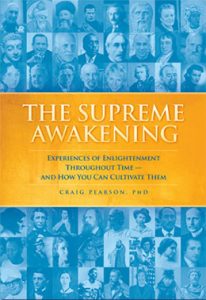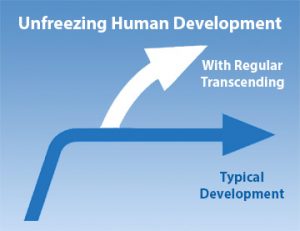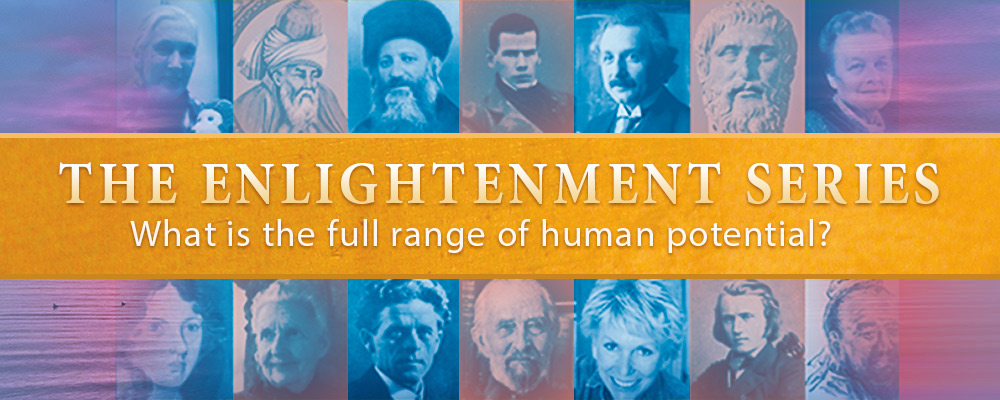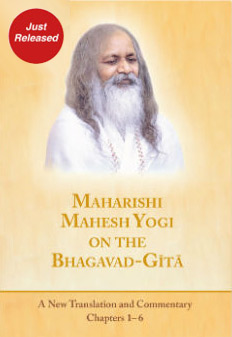Throughout history, great men and women have described exalted experiences, moments of extraordinary wakefulness, freedom, and bliss—as different as our ordinary waking experience is from dreaming. Laozi, Plato, Rūmī, St. Teresa of Avila, Emerson, Emily Dickinson, Black Elk, Einstein—people of all times and places have described experiences that rank among the most inspiring in all of literature.

The Supreme Awakening is now available as an ebook on Kindle
The Supreme Awakening brings together a rich and diverse collection of these experiences, along with those reported by people who practice the Transcendental Meditation (TM) technique.
It explains these experiences in terms of a new, expanded framework of human development and enlightenment—the model of higher states of consciousness developed by Maharishi Mahesh Yogi, the renowned teacher of the ancient Vedic tradition, scientist of consciousness, and Founder of the TM program.
The sublime experiences reported by great people across time are real, universal, understandable in terms of modern science, and available to everyone: Anyone can systematically cultivate these experiences through the TM technique—simply, naturally, and effortlessly.
The following excerpts provide a glimpse of the unlimited possibilities for human development and enlightenment, with descriptions of experiences of higher states of consciousness from TM practitioners.
The sublime experiences reported by great people across time are real, universal, understandable in terms of modern science, and available to everyone.
Ultimate Human Development in Higher States of Consciousness
From the mid-1950s forward, as increasing numbers of people around the world started practicing the Transcendental Meditation technique and experiencing Transcendental Consciousness, they began describing exalted experiences outside of meditation as well.

Maharishi’s classic work, Science of Being and Art of Living
In response to these experiences, Maharishi brought to light a clear, complete, and systematic understanding of human development. In hundreds of videotaped lectures and discussions, he described the nature and dynamics of higher states of consciousness. He also described higher states in a number of books, including the Science of Being and Art of Living and Maharishi Mahesh Yogi on the Bhagavad Gita: A Translation and Commentary, Chapters 1–6.1
For most psychologists, the “endpoint” of mental growth, the highest level of cognitive development adults can reach, occurs in adolescence, when we gain the ability to think logically and abstractly—although as many as 60 percent of adults have not reached this stage.2 We may continue to change after adolescence, refining or extending capacities we have already developed, but no major growth beyond this final stage is commonly acknowledged.
But in the Vedic understanding of human potential that Maharishi brought to light, the common “adult” level of growth is only the starting point. Complete human development involves growth through a series of higher states of consciousness. Maharishi’s model comprises seven states of consciousness altogether, of which waking, dreaming, and deep sleep are but the first three.
In the Vedic understanding of human potential that Maharishi brought to light, the common “adult” level of growth is only the starting point.
Unfreezing Human Capacities and Development
Scientific studies have detailed the cumulative effects of Transcendental Meditation practice. Regular transcending triggers a remarkable growth process encompassing every area of life. The benefits, including increased intelligence and creativity, improved health, balanced personality development, and improved relationships, are often unprecedented.

The effects of TM practice go beyond relaxation and stress release, activating fundamental growth of higher capacities
Human development levels off in adolescence, as shown in measures of intelligence, field independence, moral maturity, and ego development. But regular transcending through the TM program expands consciousness, integrates brain functioning, and promotes human development even after it has plateaued.3
For example, intelligence (IQ) grows during childhood, then typically levels off in adolescence, around the same time physical growth plateaus, with a slow decline beginning around age 26. But with regular experience of transcending, intelligence resumes growing, regardless of age, indicating that the “freezing” of growth in adolescence can be “unfrozen” and that human development need not stop.4
The same is true of moral maturity, field independence, and ego development, all of them profound measures of personal growth: All level off in adolescence, but all resume their growth with regular TM practice.
The TM technique is widely appreciated as an effective means of reducing stress, but what we are seeing here goes far beyond relaxation and stress release. We are looking at a fundamental activation of human growth, especially of our higher human capacities.
With regular experience of transcending, intelligence resumes growing, regardless of age, indicating that the “freezing” of growth in adolescence can be “unfrozen” and that human development need not stop.
Transcending Is the Gateway to Higher States
The fourth state of consciousness, Transcendental Consciousness, which we experience during the TM technique, forms the gateway to higher states. With regular experience of the fourth state, the three higher states develop naturally. To the fifth, sixth, and seventh states of consciousness, Maharishi gave the names Cosmic Consciousness, Refined Cosmic Consciousness or God Consciousness, and Unity Consciousness.

Transcendental Consciousness is experienced during the TM technique
Each state of consciousness is a progressive stage of awakening, of enlightenment. Each opens a distinctive new world of experience and knowledge, as different from the waking state as waking is from dreaming. And each has a corresponding style of physiological functioning, a unique physiological signature.
If the idea of higher states of consciousness seems abstract, the benefits are concrete and immensely practical. The Transcendental Meditation program has been utilized in schools and universities, boardrooms and factories, substance abuse clinics and prisons, as well as homes for the elderly and programs for veterans with post-traumatic stress. In all settings, the simple experience of daily transcending has produced breakthrough results.
But these results are merely byproducts of the technique’s ultimate purpose: to cultivate higher states of consciousness—enlightenment.
Each state of consciousness is a progressive stage of awakening, of enlightenment. Each opens a distinctive new world of experience and knowledge.
Fundamentals of States of Consciousness
Maharishi put forward two basic principles of states of consciousness:
Knowledge is different in different states of consciousness. As we shift from one state of consciousness to another, we move from one world to another. Each state involves a unique mode of knowledge and experience, of ourselves and the surrounding world.
The world of the waking state, for example, differs radically from the illusory dream world. Both differ radically from the world of deep sleep. Similarly, each higher state of consciousness is a world in itself.
Each state of consciousness has a unique mode of physiological functioning. A physiologist can tell whether you are awake, dreaming, or asleep by measuring your breath rate, brainwaves, and so on. When you shift from one state to another, your physiology switches to a different style of functioning.
Accordingly, higher states of consciousness develop when the physiology reaches specific thresholds of purification and integration. Growth of higher states thus has nothing to do with adopting new ideas, attitudes, or moods. Rather it depends on cultivating coherent brain functioning and refining and purifying the nervous system, culminating in optimal integration and balance. Without these refinements, higher states cannot develop.5
Growth of higher states… depends on cultivating coherent brain functioning and on refining and purifying the nervous system, culminating in optimal integration and balance.
7 States of Consciousness—the Full Potential of Mind and Body
1. Deep Sleep State

Deep sleep and dreaming are essential for health and well-being
Sleep is a physical and mental state of rest during which we become inactive and unaware of our surroundings. We spend 75–80 percent of our sleeping time in non-REM (rapid eye movement) sleep.
Most physiological functions slow down. Body temperature, blood pressure, and breathing rate all drop. Sensory and motor activity become suspended, voluntary muscles become inactive, and we become totally or partially unconscious.
The brain, however, remains active throughout sleep—as active, according to some studies, as during waking.
2. Dreaming State
At various periods during sleep, we enter the dream state, the illusory, unpredictable world where familiar laws of nature release their hold and anything can happen—improbable shifts in time and place, unfamiliar combinations of people and events.
Most dreaming takes place in REM sleep, comprising about 25 percent of our sleep time. Brainwave activity during REM sleep resembles that of the waking state except that the brain inhibits signals to the muscles so we cannot act out our dreams.
Sleeping and dreaming are critical for our physical and emotional health. Each stage of sleep furnishes important benefits, whether regenerating neurons, generating new synaptic connections in the cerebral cortex, processing memories, or integrating what we learned during the day. The brain’s activity during sleep may also support creativity and assist problem-solving.
Sleeping and dreaming are critical for our physical and emotional health. Each stage of sleep furnishes important benefits.
3. Waking State
The waking state is the familiar, ever-changing world of concrete sensory experience, of people and places, things and events. From the outer world we perceive through our senses to the inner world of thoughts and feelings, our waking state experience is in constant flux, while physiological functioning is more active.
Our perception of reality may vary enormously through the day, depending on whether we are rested or tired, calm or agitated, attentive or bored, happy or depressed, healthy or ill.
The waking state is the familiar, ever-changing world of concrete sensory experience, of people and places, things and events.
4. Transcendental Consciousness—the Fourth State of Consciousness
In Transcendental Consciousness, which we experience during our TM practice, attention has settled inward, beyond perceptions, thoughts, and feelings. What remains is the experience of consciousness in its pure form, awake to itself alone—unbounded pure awareness, our innermost Self. Simultaneously the body becomes deeply restful while brain functioning becomes integrated, suggesting the total brain is awake. See “How Transcending Optimizes Your Brain” ►

During TM practice, the mind transcends and experiences the fourth state of consciousness
What are you experiencing in this state? Your consciousness is free of content, awake but without perceptions, thoughts, and feelings. The sea of consciousness is aware only of itself, unmixed with anything else. Maharishi calls this a state of pure consciousness, pure awareness, pure wakefulness.
Experiences during TM practice, Maharishi explains, will vary from person to person and from day to day, depending on the condition of the nervous system, whether fresh or fatigued, relaxed or stressed.
When one first learns to meditate, one may experience Transcendental Consciousness only for brief moments, at the deepest points of meditation. The experience is so natural that one may hardly be aware of it. In time, with regular TM practice, the experience lasts for longer periods, first during meditation, then outside as well.
Experiences of Transcendental Consciousness
Each person’s experiences will be unique, depending on the ever-changing condition of their individual nervous system. Maharishi emphasizes the importance of remaining innocent. We never look for or try to produce any specific experience in our TM practice.
Here is how one TM practitioner describes the experience of Transcendental Consciousness:
“During the Transcendental Meditation technique, my mind settles down, thoughts become less and then suddenly all thought activity ceases and I slip into an unbounded ocean of awareness which is pure, quiet, unexcited, and infinitely extended beyond space and time. In this state, I am not aware of any thought or any thing; I am just aware of awareness, you could say, wide awake inside but not thinking. Simultaneously my body settles down, breathing becomes less, and I feel relaxed.”6
Another meditator describes the expanded, infinite aspect of the fourth state of consciousness:
“During the practice of the Transcendental Meditation technique, I sometimes reach a state of complete silence, which has come about very innocently. The experience is one of evenness and expansion, of infinity, and I am that infinity.”7
The sea of consciousness is aware only of itself, unmixed with anything else. Maharishi calls this a state of pure consciousness, pure awareness, pure wakefulness.
Would you like to share your experiences of transcending during your TM practice or of growing higher states of consciousness in your life? We are collecting written experiences from TM Meditators around the world and would like to include yours. Please note: We never share any information without your expressed permission. Please share your experience as a Comment at the end of this article.
5. Cosmic Consciousness—the Fifth State of Consciousness
If the mind can become fully awake for short periods of time, as it does in Transcendental Consciousness, can it remain fully awake permanently? The answer is: it can. And with repeated transcending, it does.
Gradually, with regular experience of Transcendental Consciousness through the TM technique, the mind and body become accustomed to this style of functioning. One spontaneously maintains unbounded awareness, the fully expanded state of mind, at all times, along with waking, dreaming, and sleeping. The physiology becomes free of stress, and brain functioning remains integrated throughout the day.

In Cosmic Consciousness the mind is fully expanded and awake, along with waking, dreaming, and sleep states
With regular TM practice, Transcendental Consciousness becomes permanent, forming an underlying continuum that coexists with waking, dreaming, and sleeping. These three states continue to come and go as before. But the underlying continuum of pure consciousness is never broken. The experience of inner silence is never lost—the inner light of the Self is never extinguished.
This is a fifth state of consciousness, altogether different from waking, dreaming, sleeping, and Transcendental Consciousness.
This fifth state Maharishi terms Cosmic Consciousness. Cosmic means all inclusive, all encompassing. In Cosmic Consciousness, the mind is fully expanded. The ocean of consciousness is awake to its depth.8
See “What Is Cosmic Consciousness?” ►
With regular TM practice, Transcendental Consciousness becomes permanent, forming an underlying continuum that coexists with waking, dreaming, and sleeping. The experience of inner silence is never lost—the inner light of the Self is never extinguished.
Experiences of Growing Cosmic Consciousness
The experience of growing Cosmic Consciousness is natural, normal, and enjoyable. As your nervous system becomes progressively free of stress, you spontaneously express more of your inner potential. You grow in creativity and intelligence, alertness and evenness, happiness and fulfillment.
Cosmic Consciousness does not involve some new kind of thought, attitude, or mood. It is a direct and continuing experience of the silent and unbounded field of pure consciousness, which was once hidden by physical and mental stress. It becomes the eternal background of all experience.9
Here is how one TM practitioner describes the experience of growing Cosmic Consciousness:
“The experience of bliss consciousness has become more clear, intense, and stable not only during Transcendental Meditation but also during activity. Now I find that a soft but strong feeling of blissful evenness is present most of the time in both mind and body. Physically, it is experienced as an extremely delightful liveliness throughout the body.
“This evenness is so deep and stable that it is able to maintain its status even in the face of great activity. Even when faced with great problems, this blissful evenness of mind and body continues. Every day it grows stronger and more stable. The evenness cushions one against all possible disruptions and makes all activity easy and enjoyable. Every place is heaven when you feel that evenness. One is completely self-sufficient. Nothing can prevent one from having that fabulous inner mental and physical blissfulness.”10
This blissful inner wakefulness continues during sleeping and dreaming states as well, as this meditator describes:
“Often during deep sleep, I am awake inside, in a very peaceful, blissful state. Dreams come and go, thoughts about the dreams come and go, but I remain in a deeply peaceful state, completely separate from the dreams and the thoughts. My body is asleep and inert, breathing goes on regularly and mechanically, and inside I am just aware that I am.”11
Cosmic Consciousness brings a transformation of life. The body is now virtually free of stress, consciousness is unbounded, and we are ever anchored in the Self. We enjoy absolute freedom and 24-hour bliss. We live in accord with natural law, with nature supporting our every thought and action.
The experience of growing Cosmic Consciousness is natural, normal, and enjoyable. As your nervous system becomes progressively free of stress, you spontaneously express more of your inner potential.
6. Refined Cosmic Consciousness—the Sixth State of Consciousness
What remains to be developed? In Cosmic Consciousness, although consciousness is unbounded, our senses still experience the outer world superficially, much as in the ordinary waking state. The world remains a collection of things, separate from each other and separate from one’s Self. If there is to be further growth, Maharishi points out, it will have to be in our relationship with the world around us.

In the sixth state of consciousness, the senses perceive the subtlest levels of nature
Cosmic Consciousness provides the platform from where our perceptual machinery becomes profoundly refined. With unbounded awareness now established on the level of the conscious mind, and with the physiology now virtually free of stress, the organs of perception now embark upon a remarkable and spontaneous process of refinement. We gain the ability to perceive finer and finer levels of nature, increasingly subtle strata of creation.
In time, perception becomes so exquisitely refined that we can discern nature’s subtlest material structure. In everything around us, we perceive what Maharishi terms the finest relative domain of nature—the most delicate, most refined value of matter, or “relative” existence.
This represents an altogether new state of consciousness, distinctly different from Cosmic Consciousness. Now, unbounded awareness is coupled with perception of the finest relative. Perception now embraces the entire range of relative life, from surface values to the subtlest material level—the full majesty of God’s creation. Maharishi calls this state Refined Cosmic Consciousness or God Consciousness.
What is the nature of this finest relative level of life? Maharishi describes it as vibrant infinity, vibrant Absolute.12 The essential nature of this finest relative field is light, which Maharishi has described as “the self-illuminant effulgence of life.”13
In time perception becomes so exquisitely refined that we can discern nature’s subtlest material structure. In everything around us, we perceive what Maharishi terms the finest relative domain of nature.
Experiences of Refined Cosmic Consciousness
As this state of consciousness grows, all the physical senses become refined. Through every channel of perception—sight, sound, smell, taste, touch—we experience the subtlest, most celestial values. Every perception becomes nourishing, a wave of joy. We enjoy greater harmony, evenness, and intimacy in the quality of our vision, our emotions, the whole of our life.14
The following passage, reported by an advanced practitioner of the TM technique, describes the experience of increasingly refined perception:
“Generally, whenever I put my attention on an object (e.g., when looking at scenery out the window or sitting in the kitchen), I become aware of the subtler qualities of the objects around me. For instance, when looking at a tree, I first become aware of the object as it is—a concrete form bound in space and time. But then I perceive finer aspects of the object coexisting along with its concrete expression.
“On this subtler level, objects are perceived as almost transparent structures of soft, satiny light (unlike harsher, normal daylight) through which the very essence of life appears to flow. This flowing field of life underlies and permeates the objects of perception. Perceiving these finer aspects of creation completely nourishes the finest aspect of my own being.”15
Another TM practitioner describes refined perception and a growing intimacy with the surrounding world:
“I noticed an ever-increasing evenness, balance, and concrete smoothness developing. The contrast between meditation and activity grew less and less, and my focus on difference began to recede as harmony and smoothness began to predominate…
“Often I would have long periods of the day when everything I saw seemed to be glowing with divine radiance. Sometimes I would even be able to see the tremendous energy at the basis of every object, minute particles of energy (light?) moving very rapidly at a different rate and pattern for every object, yet unified somehow in a ‘unified field.'”16
Every perception becomes nourishing, a wave of joy. We enjoy greater harmony, evenness, and intimacy in the quality of our vision, our emotions, the whole of our life.
7. Unity Consciousness—the Seventh State of Consciousness
The seventh state of consciousness, Unity Consciousness, is the pinnacle of human evolution: One experiences everything in terms of one’s Self—the same Self we first experienced in Transcendental Consciousness as our innermost reality. Human development culminates in the ability to experience all things in terms of the underlying oneness from which all creation emerges. In this state, one lives a totally awakened and integrated life.
Refined Cosmic Consciousness, or God Consciousness, brings an extraordinary capacity of perception and knowledge—everything shines with awe-inspiring, effulgent beauty. Yet knowledge remains incomplete. The ultimate, transcendental reality of nature remains hidden, concealed behind the thinnest of veils, the finest material level of nature itself. The final stroke of growth carries us across this last threshold.
How does this occur? As one’s unbounded awareness falls on the finest relative value in everything one perceives, it begins to enliven the unmanifest, transcendental field that pervades the finest level of nature. This involves a new mode of experience—the cognition of infinity within the finest relative perception.

In Unity Consciousness, we experience the Self within everything and everything within the Self
When this happens, the distinction between the Self and the non-Self dissolves. They become unified. The transition to Unity Consciousness simply involves the recognition of this reality. In Maharishi’s words, “It is only the knowledge that was hidden and is now unfolded.”17
When we look out onto the ocean, we see individual waves, but what dominates our experience is the ocean as a whole. Similarly, in Unity Consciousness, we see the boundaries of relative life as always, but they no longer overshadow the unity at their basis.
The fullness of the ocean of pure consciousness radiates through every wave of everyday life. Now we experience the Self within everything and everything within the Self. Dominating every faculty of perception—sight, hearing, touch, taste, and smell—is the unbroken wholeness of unbounded awareness.
In this state, Maharishi explains, every object becomes as dear as one’s own Self, for you experience that every object is your Self. Transcendental Consciousness fulfilled the precept Know thyself. Unity Consciousness fulfills the precept Love thy neighbor as thyself—for in this state you experience your neighbor literally in terms of your Self.
Unity Consciousness is the pinnacle of human evolution: One experiences everything in terms of one’s Self—the same Self we first experienced in Transcendental Consciousness as our innermost reality.
Experiences of Growing Unity Consciousness
The following two examples of experiences of Unity Consciousness were gathered from TM practitioners during a research project.18 They describe the progression from experiencing pure consciousness deep within to beginning to experience it within everything:
“When walking outside, I notice the scenery filled with some new quality, some vitality, beyond description. I see both the unbounded and boundaries existing together, both the tree and the sky as one underlying wholeness, the finite and the infinite blended together in one totality. It is indescribable to be seeing the same scenery in a different way, without having done anything. I see infinity expressed everywhere, and nowhere can I find the finite only.”
Here, an advanced TM practitioner describes the growing experience of the Self in everything as filled with joy and love:
“Increasingly I experience everything and everyone as nothing other than my own Self. This is especially clear when walking in the woods but is also apparent in town or anywhere. It seems that Being [pure consciousness] is shining and glistening and even smiling at me from the surface of everything.
“This is difficult to describe. How does one perceive Being in activity? It’s as if the inner Being, the Self of everything, somehow rises to the surface and makes itself apparent. It is a truly simple experience, and truly beautiful and magnificent.
“With this experience of becoming aware of my own Self in all things, love begins to flow—love without boundaries, without exceptions, without considerations of any sort. Love flows out towards all that I perceive and seems to flow back to me as well.
“This is simply an augmentation of the experience of Being that became a constant feature of my own waking, dreaming, and sleeping awareness for the past two and a half years—it’s just that the experience of Being has become ever more insistent, ever more dense around me and in my awareness, ever more powerful.
“And now it has become apparent in all things. Yet, as subtle as this change is, it is also huge. This experience is utterly full of delight, full of joy, full of bliss, and, as I have said, full of love.”
“With this experience of becoming aware of my own Self in all things, love begins to flow—love without boundaries, without exceptions, without considerations of any sort.” —TM practitioner
Enlightenment Is the Birthright of Everyone
Maharishi’s great work was to bring the Transcendental Meditation technique and the practical reality of enlightenment into the mainstream, as well as into the arena of scientific research, vastly expanding the scope of scientific inquiry and the scientific understanding of human potential.
Human beings are born not to suffer but to enjoy, Maharishi said—they need only develop their unbounded potential. The experience of transcending is the missing catalyst.
Transcendental Consciousness is a natural state. Everyone has the ability to experience it—every human brain is hard-wired with the potential to function coherently. And the Transcendental Meditation technique gives that experience effortlessly.
Maharishi’s model of seven states of consciousness represents a unique contribution to our understanding of human potential and how it develops. He has put forward a systematic, comprehensive, detailed understanding of human development and placed it in the arena of empirical science. He has described the transformations in knowledge, experience, and physiological functioning that come with each higher state. And he has provided simple, natural techniques for cultivating higher states of consciousness.
Human beings are designed for enlightenment; it is everyone’s birthright. With the simple technique for transcending that Maharishi has revived, anyone and everyone can grow to enlightenment.
Human beings are designed for enlightenment; it is everyone’s birthright. With the simple technique for transcending that Maharishi has revived, anyone and everyone can grow to enlightenment.
Would you like to share your experiences of transcending during your TM practice or of growing higher states of consciousness in your life? We are collecting written experiences from TM Meditators around the world and would like to include yours. Please note: We never share any information without your expressed permission. Please share your experience as a Comment at the end of this article.
Learn more about higher states of consciousness at EnjoyTM.org ►

Craig Pearson, Ph.D., is the author of The Supreme Awakening: Experiences of Enlightenment throughout Time—And How You Can Cultivate Them (Fairfield, IA: MIU Press, 2014).
Dr. Pearson is Vice President of Academic Affairs at Maharishi International University in Fairfield, Iowa, and an expert in Consciousness-BasedSM Education. He speaks around the United States and internationally on the topic of human development and higher states of consciousness.
Order a copy of The Supreme Awakening ►
The Supreme Awakening is also available for Kindle ►



Comments